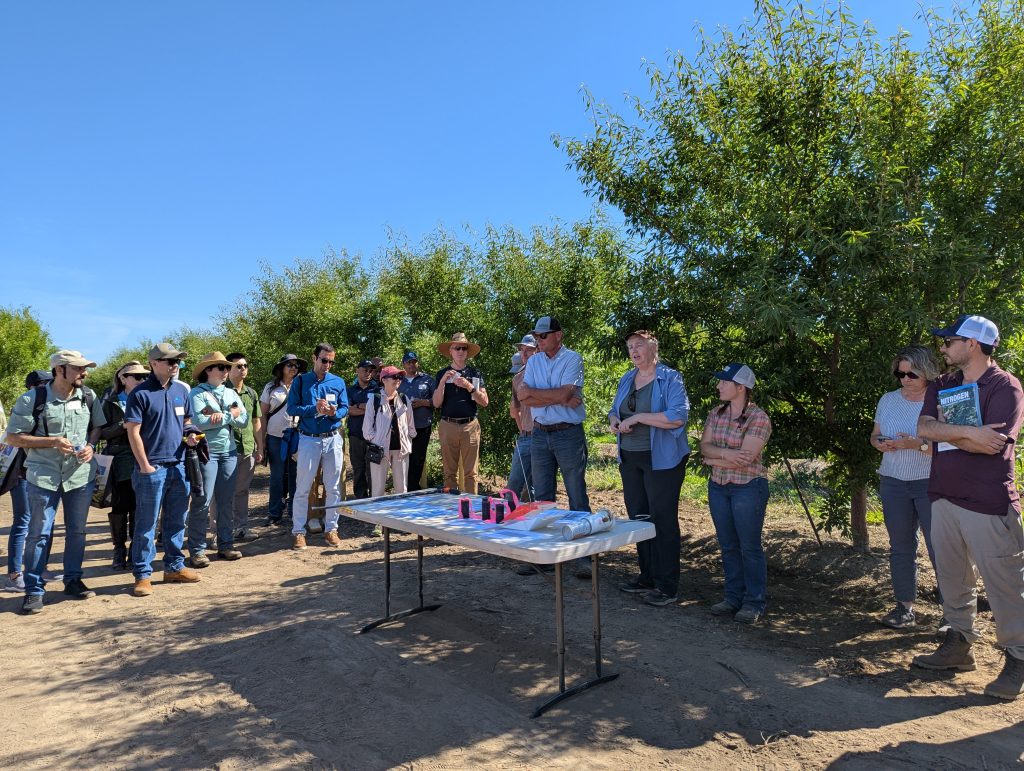
Almonds are California’s #1 export crop for good reason. No place in the world has a climate better suited to consistent, high-quality almond production. Furthermore, the constricting labor market in the state has encouraged farmers to move towards almonds, with their relatively lower maintenance. With 1.5 million acres planted with almonds – out of no more than 9 million irrigated acres overall – it should be no surprise that California has also become the center of research into sustainable almond production. And it is heartening to know that this research has benefits for the management of other orchard crops, and for the efficacy of state programs.
It has increasingly made sense to combine research projects in the same orchards, describing the system in a more complete way than any single researcher can do. To this end, three collaborative projects stand out especially.
At Paramount Farms, near Lost Hills, a diverse team of researchers studied effects such as:
- nitrate leaching
- fertilizer off-gassing as the GHG nitrous oxide
- fertilizer nitrogen (N) distribution within trees
- remote sensing of N needs
- water use
- plant water stress
- plant chlorophyll levels
- irrigation techniques
- nutrient cycles
- measuring and predicting nut yields and qualities.
According to the researchers, this project defined the modern accepted guidelines for N management in Almond, including producers overseas. The work has changed industry practices and reduced fertilizer inputs and the impacts of excess N.
For more information about this project you can contact Patrick Brown, phbrown@ucdavis.edu.
At Bowman Farms, near Modesto, scientists have been focusing on long-term N management through testing and modeling of:
- high-frequency (low-concentration) N fertilization through the irrigation system
- N leaching into groundwater, especially as affected by distribution of irrigation water and N
- soil permeability prediction systems
- almond tree water use at different ages
- groundwater recharge effects
According to the researchers, the Bowman long-term studies are longest-running to date for a single almond orchard.
For more information about this project you can contact Thomas Harter, thharter@ucdavis.edu.
At TriNut Farms in Stanislaus County, the emphasis has been on climate-smart practices, and particularly on combining (“stacking”) them, to identify synergies and tradeoffs. While assessing
- whole-orchard recycling
- biochar at planting
- compost
- cover crops,
Researchers are studying their effects on:
- soil health
- soil carbon
- tree nutrition from the soil
- biodiversity
- orchard productivity
- nutrient cycling
- ground-truthing remote sensing of tree development with Ceres AI
According to the researchers, they are also monitoring commercial orchards across the Central Valley to see how these practices perform at scale.
For more information about this project you can contact: Sat Khalsa: sdskhalsa@ucdavis.edu.
The funding of these projects has come from various sources, including CDFA’s Fertilizer Research and Education Program, which is funded by an excise tax on fertilizer sales; federal Specialty Crop Block Grants, which are administered by CDFA; other federal sources; grower members of the Almond Board and Pistachio Research Board; and industry.
The completeness of the data gained from these orchards allows important insights. Models for predicting N management effects on the environment are being developed, including for use in state programs; growers are benefiting from more efficient fertilizer and water management; and other practices, such as Whole Orchard Recycling, compost application, and groundwater recharge, have been have been validated by new data, preparing them for more public support. The outcomes and findings of such projects can help form the decisions of growers who apply for HSP and SWEEP funding, as they design their future orchard management.
OARS staff will continue to visit these project sites and monitor results to design science-based improvements to our incentive grant programs.


Dear Sirs/Madams,
Good evening! I am an agronomist and horticulturist. My research center was established jointly by the USDA/NRCS and the USDA/ARS in 1988. We have invested over $6.5 million and worked on more than 45 horticultural crops.
I have been doing Soil Health studies on Muscadine grapes for the last 25 years in collaboration with the National Soil Health Lab at Cornell National Soil Health Lab. This national lab has rated my research as “Excellent”. It is the first long-range organic soil health study on a vineyard in the U.S.
I would like to introduce my research program on the Vineyards and Orchards of California to keep the soil and humans healthy.
Hello Girish,
We will reach out via email and connect you with our Healthy Soils supervisor.